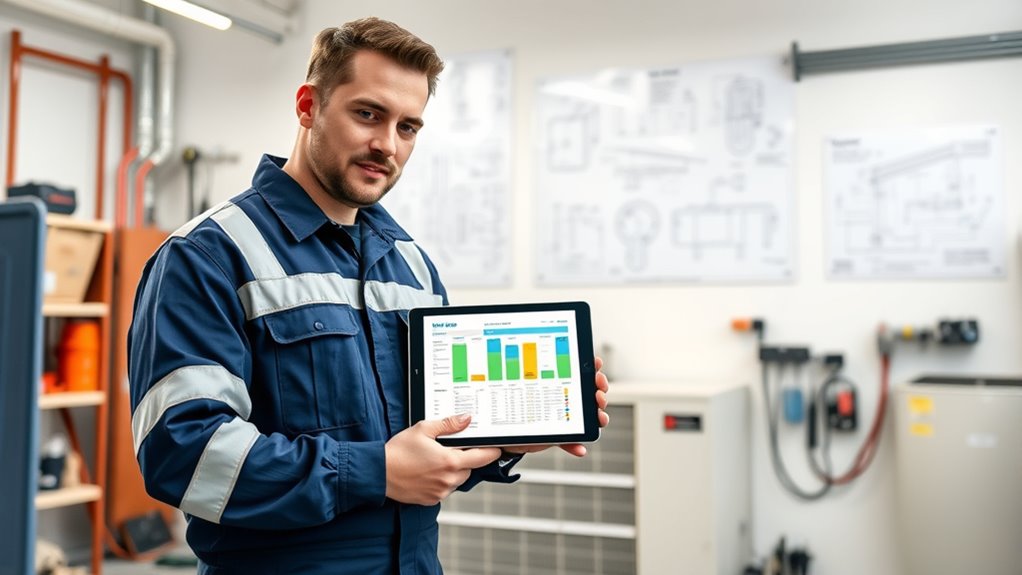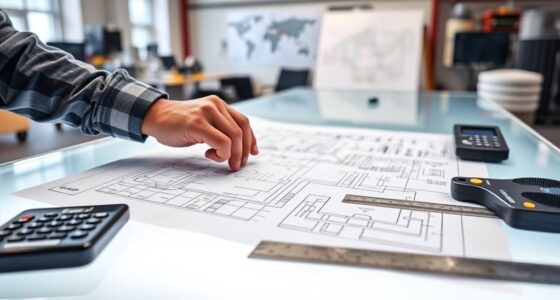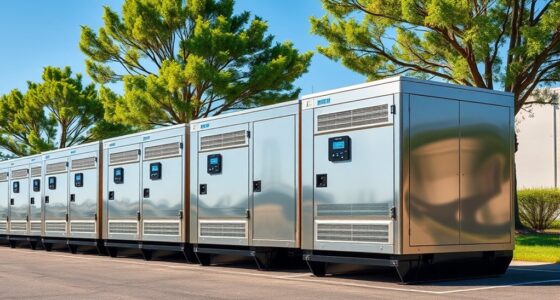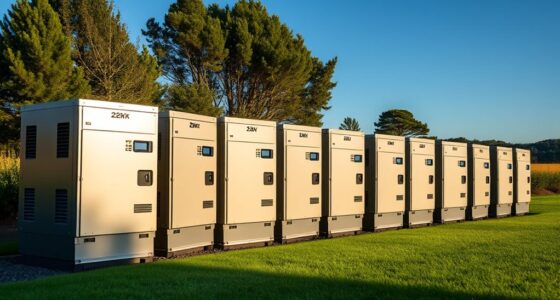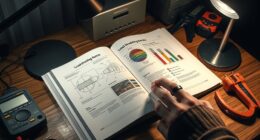To size your heat pump or well pump correctly, you need to ensure your home’s size, insulation, climate, and household water demand. Proper sizing prevents overworking and guarantees efficiency, saving you money and extending equipment life. Factors like well recharge rates and home layout also matter. If your system runs constantly or cycles rapidly, or if you’re unsure, consulting an expert can help you achieve optimal performance. Keep going to discover how these steps make a difference.
Key Takeaways
- Proper sizing ensures efficiency, reduces energy costs, and extends equipment lifespan for heat pumps and well pumps.
- Climate, home layout, and insulation levels significantly influence the correct system size.
- Use load calculations, well yield tests, and performance charts for accurate pump capacity determination.
- Signs of improper sizing include frequent cycling, high energy bills, noise, and inconsistent water pressure.
- Consult professionals for precise assessment and optimal system sizing tailored to your home’s needs.
How Do I Determine the Proper Size for My Heat Pump?
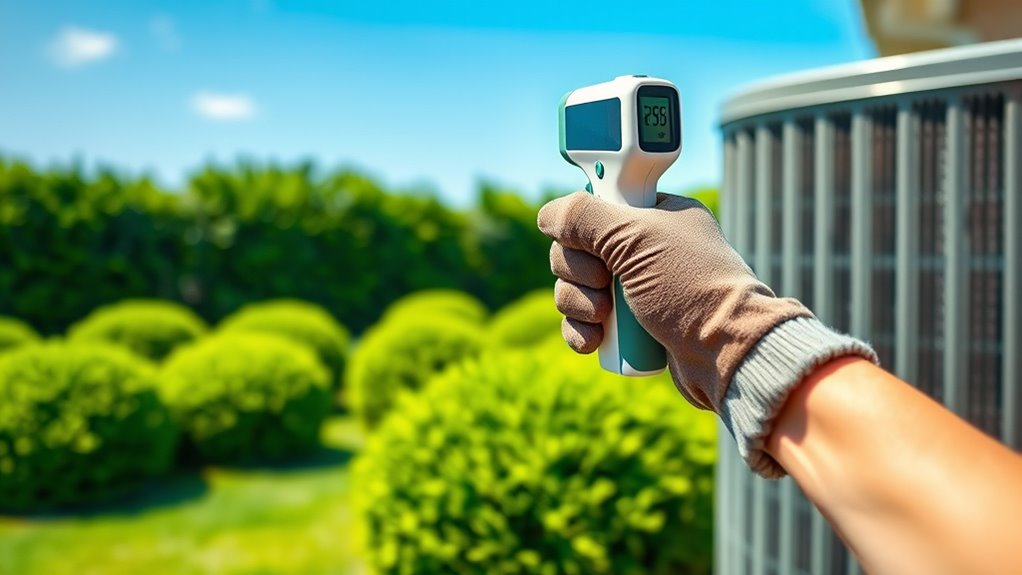
Determining the proper size for your heat pump is vital to guarantee efficient heating and cooling. An appropriately sized unit maximizes energy efficiency, helping you save on monthly energy bills. If your heat pump is too small, it’ll struggle to heat or cool your space, running constantly and increasing wear and tear. Conversely, a unit that’s too large will cycle on and off frequently, wasting energy and decreasing efficiency. To find the right size, consider your home’s square footage, insulation quality, and climate. Proper sizing minimizes cost implications over time by reducing energy consumption and extending the lifespan of your system. Consulting a professional ensures you select a heat pump that suits your specific needs, balancing performance with long-term savings. Additionally, understanding load calculations can help determine the most accurate size for your system.
What Factors Affect the Size of a Well Pump?
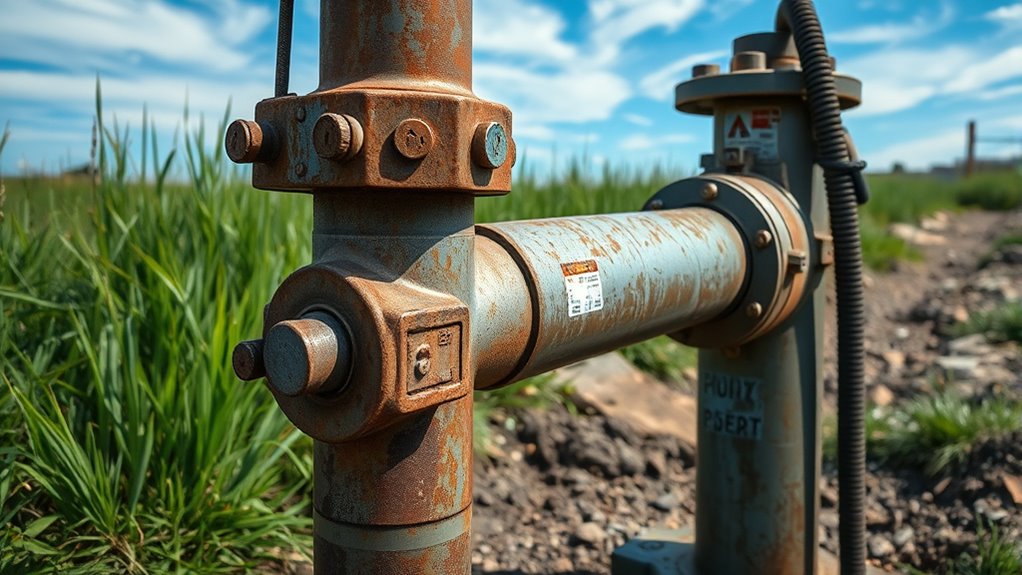
The size of your well pump depends on several key factors that directly impact its performance and longevity. One essential aspect is aquifer recharge, which affects how much water is naturally replenished in your well. A slower recharge rate means you’ll need a pump that can operate efficiently without over-pumping, preventing damage and extending pump longevity. Additionally, the depth of your well and the required flow rate influence pump size—deeper wells need more powerful pumps to lift water effectively. The demand for water in your household also plays a role; higher usage requires a larger pump to maintain consistent pressure. Considering these factors guarantees your pump is appropriately sized, promoting reliable operation and protecting its lifespan over time. Properly understanding well system components can help optimize your pump selection and ensure long-term efficiency.
Why Is Correct Sizing Important for Efficiency and Cost Savings?
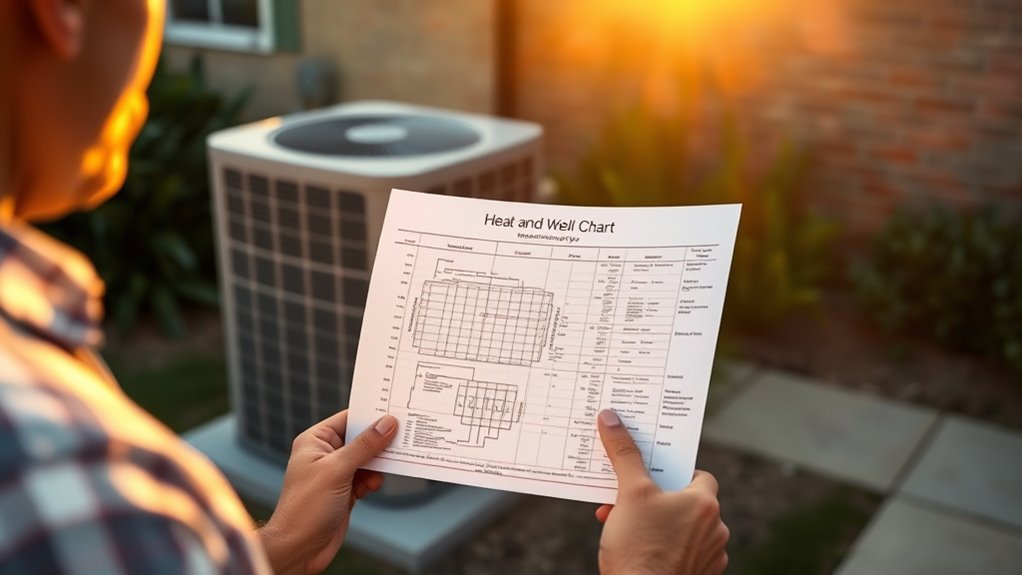
Choosing the right size keeps your equipment from overworking and wearing out prematurely. When your system is properly sized, it runs efficiently and provides reliable performance. This not only saves you money but also extends the lifespan of your pump and heat system. Incorporating mindful decluttering strategies can also help you better assess and maintain your equipment and storage needs, ensuring optimal performance.
Prevents Overworking Equipment
When a heat pump or well pump is improperly sized, it can lead to excessive wear and tear on the equipment. This overworking shortens your pump’s lifespan and decreases energy efficiency. Oversized pumps cycle on and off frequently, causing unnecessary stress, while undersized pumps run constantly, wearing out faster. Proper sizing guarantees your equipment operates within ideal parameters. Additionally, selecting the correct size can optimize Kia Tuning benefits, ensuring your vehicle performs reliably and efficiently.
| Pump Size | Effect on Equipment |
|---|---|
| Too large | Frequent cycling, wear out quickly |
| Too small | Overworking, reduced lifespan |
| Correct | Smooth operation, longer lifespan |
| Impact | Better energy efficiency, less maintenance |
Ensures Optimal Performance
Properly sizing your heat pump or well pump guarantees it operates at peak performance, maximizing energy efficiency and reducing your utility bills. When your equipment is correctly sized, it maintains efficiency optimization, meaning it uses only what’s necessary without overexerting. To guarantee this, follow essential installation tips like proper placement and accurate load calculations. Additionally, understanding projector technology can help in designing spaces that complement your equipment and optimize performance.
How Do Climate and Home Layout Influence Heat Pump Sizing?
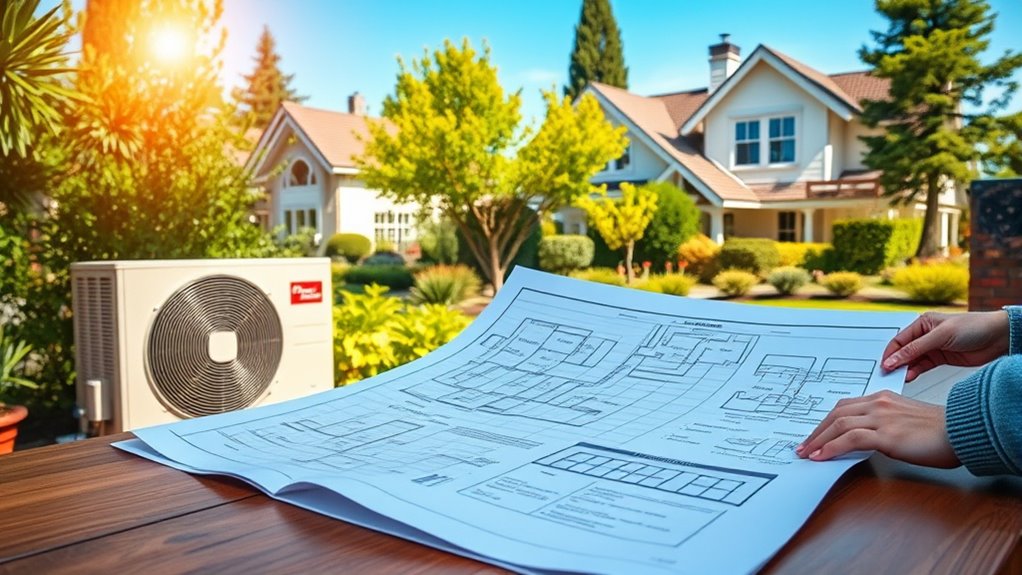
Climate and home layout play essential roles in determining the right size for your heat pump. In colder climates, you’ll need a larger unit to handle extreme temperature drops, requiring effective climate adaptation strategies. Conversely, milder climates may allow for a smaller, more efficient system. Your home’s design also influences sizing—high ceilings, open floor plans, and insulation levels affect heat loss or gain. Well-designed homes with good insulation need less capacity, while older or poorly insulated homes may require a bigger unit. Understanding these factors helps guarantee your heat pump provides consistent comfort without wasting energy. Proper sizing tailored to your climate and home layout maximizes efficiency, reduces wear and tear, and saves you money over time. Additionally, efficiency ratings such as SEER and HSPF are crucial to selecting a model that offers optimal performance for your specific conditions.
What Are the Common Methods to Calculate Well Pump Capacity?

To determine your well pump capacity, you’ll want to contemplate several common methods. Measuring flow rate gives you a clear idea of how much water your well produces, while pump performance charts help assess efficiency and capacity. Well yield testing provides valuable data on the sustainable amount of water your well can supply over time. Additionally, understanding your pump’s performance metrics such as suction power and energy efficiency can further assist in selecting the appropriate pump size.
Flow Rate Measurement
What are the common methods to calculate well pump capacity? You primarily rely on flow measurement and pump calibration to determine the right size. Accurate flow measurement involves gauging the volume of water the pump delivers over a specific period, often using a flow meter or a container and stopwatch. Pump calibration ensures the pump’s output matches manufacturer specifications, helping you verify its performance. Key methods include:
- Using flow meters for real-time flow rate data
- Conducting timed volume measurements with calibrated containers
- Comparing actual flow to pump specifications during calibration tests
- Employing industry-standard testing procedures to ensure consistent and reliable results
These techniques help you accurately assess well pump capacity, ensuring your system meets demand without over or under-sizing. Proper flow rate measurement is essential for ideal performance and longevity.
Pump Performance Charts
Are pump performance charts essential tools for determining well pump capacity? Absolutely. Performance curves display how a pump performs at various flow rates and depths, helping you understand its capacity and limits. These charts illustrate the relationship between flow rate and head, enabling you to select a pump that matches your specific needs. Efficiency charts further enhance your decision-making by showing the pump’s energy efficiency at different operating points. By analyzing both performance curves and efficiency charts, you can identify the most suitable pump size that provides adequate flow while minimizing energy consumption. Using these tools ensures you choose a pump that operates reliably and efficiently, preventing over- or under-sizing your well pump. Proper understanding of pump tuning techniques can optimize performance and longevity. This approach saves money and prolongs your equipment’s lifespan.
Well Yield Testing
Well yield testing provides essential data to determine the capacity of your well pump accurately. This process involves aquifer testing to assess how much water your well can produce over time. Common methods include:
- Step-Rate Test: Gradually increases pumping rates to identify the well’s maximum sustainable yield.
- Constant-Rate Test: Pumps at a fixed rate for several hours, measuring drawdown and recovery to evaluate well performance.
- Recovery Test: After pumping stops, monitors how quickly water levels rebound, indicating aquifer recharge capacity.
These methods help you understand your well’s well yield and ensure your pump is correctly sized. Accurate aquifer testing minimizes risks of over-pumping, ensuring a reliable water supply for your heat pump or well pump system. Proper vase selection can also enhance the presentation of your well-maintained floral displays.
Can I Use Online Tools or Estimators for Sizing?

While online tools and estimators can seem like a quick and convenient way to size heat pumps and well pumps, they often lack the accuracy needed for your specific situation. DIY calculators and online estimators may provide a rough estimate, but they don’t account for all variables like your home’s insulation, local climate, or well conditions. Relying solely on these tools can lead to undersized or oversized pumps, impacting efficiency and longevity. It’s better to use online estimators as a starting point and then consult a professional for precise sizing. A qualified technician will perform detailed calculations and consider unique factors that generic online tools can’t capture, ensuring you get a pump that’s just right for your needs.
What Are the Signs That My Current Pump Is Too Small or Too Large?

Knowing whether your current pump is the right size can save you money and prevent equipment issues. An undersized pump struggles to meet demand, while an oversized one wastes energy and may damage your system. To assess pump capacity and system compatibility, watch for these signs:
- The pump runs constantly or cycles on and off frequently, indicating it’s too small or too large for your needs.
- Your system takes longer to heat or cool, or doesn’t reach desired temperatures, suggesting an inadequate pump size.
- Unusual noises, vibrations, or leaks point to mismatched pump capacity or improper system compatibility.
When Should I Consult a Professional for Pump Sizing?
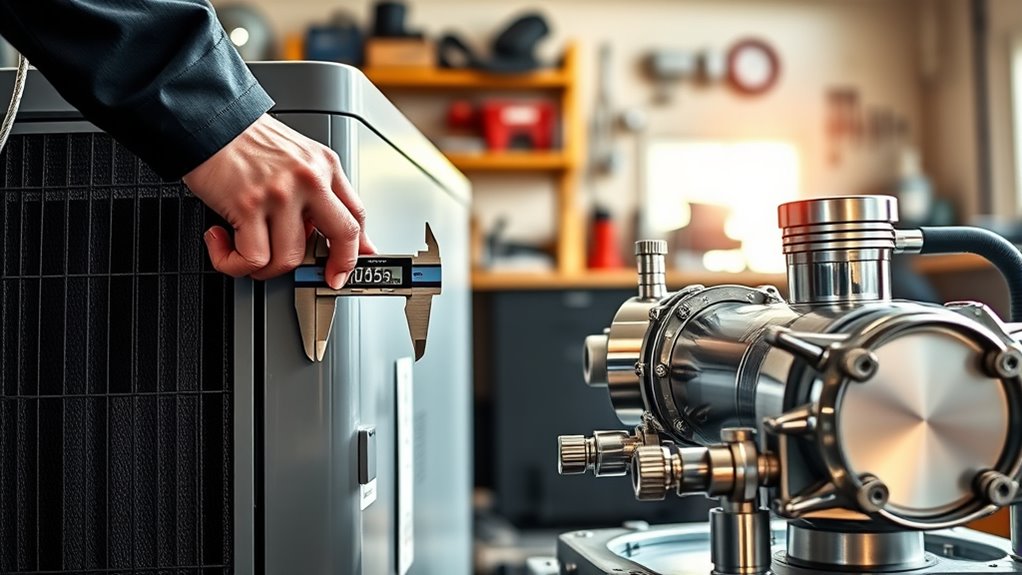
If you’re unsure whether your current pump is properly sized for your system, it’s time to consult a professional. Proper pump sizing affects both pump durability and energy efficiency, preventing premature wear or excessive energy use. A professional can evaluate your system’s requirements, ensuring the pump is neither too small nor too large. Incorrect sizing can lead to frequent breakdowns, higher maintenance costs, and reduced lifespan of your pump. Additionally, an expert can optimize energy efficiency, saving you money on utility bills. If you notice inconsistent water pressure, strange noises, or frequent cycling, these are signs you should seek professional advice. Consulting a specialist guarantees your system operates smoothly, reliably, and efficiently for years to come.
Frequently Asked Questions
Can Improper Sizing Lead to System Breakdowns or Early Failure?
Yes, improper sizing can cause system breakdowns or early failure. When your heat pump or well pump is too small, it works harder, reducing system efficiency and increasing energy consumption. Conversely, an oversized system cycles on and off frequently, leading to wear and tear. Both scenarios strain components, shorten lifespan, and ultimately cause early failure. Proper sizing guarantees ideal performance, energy savings, and longer equipment life.
How Often Should Heat Pump or Well Pump Sizing Be Reevaluated?
You should reevaluate your heat pump or well pump sizing every 3 to 5 years, aligning with maintenance schedules. Technological advancements can improve efficiency or change your system’s requirements, so regular assessments ensure ideal performance. Changes in your home’s size, water needs, or energy use also warrant remeasurement. Staying proactive helps prevent system issues, saves energy, and keeps your system running smoothly over its lifespan.
Are There Seasonal Variations That Influence Pump Sizing Needs?
Imagine your home’s needs shifting like the seasons themselves. Yes, seasonal fluctuations and climate considerations considerably influence pump sizing needs. During hot summers, your heat pump may require more capacity to handle increased cooling demands, while in cold winters, your well pump might work harder against lower water tables. Regularly assess these seasonal changes to guarantee peak performance and energy efficiency, adapting your system as the climate evolves throughout the year.
What Are the Environmental Impacts of Incorrect Pump Sizing?
Incorrect pump sizing can lead to environmental degradation by increasing energy consumption, which contributes to greenhouse gas emissions. Overly large pumps waste resources and accelerate resource depletion, while undersized pumps strain systems, causing inefficiencies and potential failures. You should size pumps correctly to reduce unnecessary energy use, protect natural resources, and minimize your environmental impact, ensuring a more sustainable and eco-friendly operation.
Is Specialized Training Required to Accurately Size Heat and Well Pumps?
Yes, specialized training is essential to guarantee accurate pump calibration and achieve proper sizing accuracy. You need to understand the complexities of load calculations, system requirements, and pump efficiency to select the right equipment. Through proper training, you’ll develop the skills to analyze site-specific data, avoid oversizing or undersizing, and optimize performance. This expertise helps prevent issues like energy waste, equipment failure, and reduced lifespan of your heat or well pumps.
Conclusion
Getting your heat pump and well pump sizes just right is like finding the perfect pair of shoes—you won’t believe how much easier and cheaper everything becomes. Size it wrong, and you might end up with a home that’s either a frozen tundra or a boiling sauna, plus sky-high bills. So don’t guess—trust the experts, use the right tools, and guarantee your home stays cozy and efficient for years to come.
